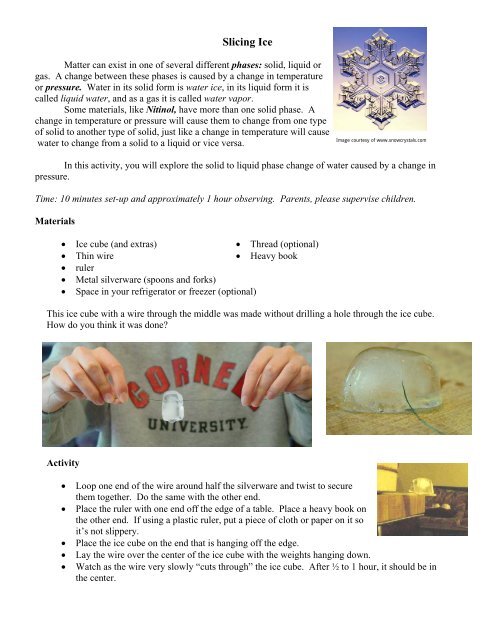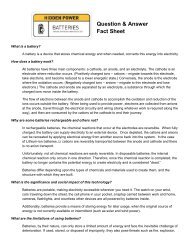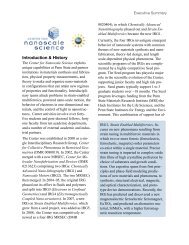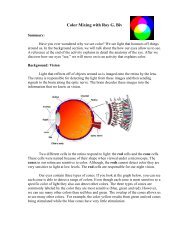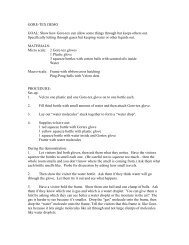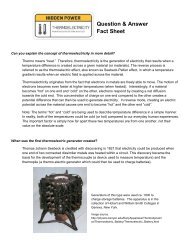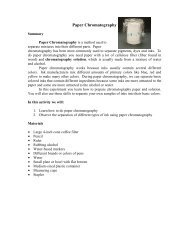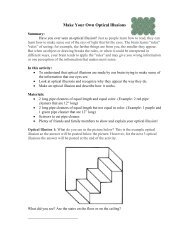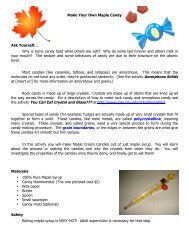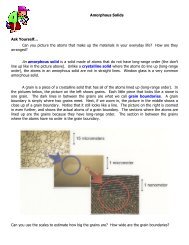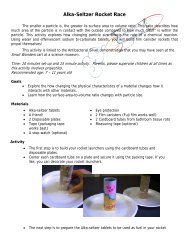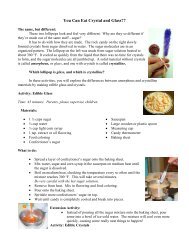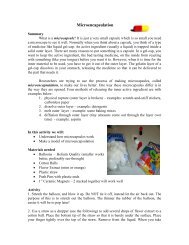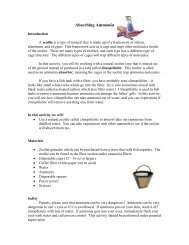Slicing Ice - the Center for Nanoscale Science
Slicing Ice - the Center for Nanoscale Science
Slicing Ice - the Center for Nanoscale Science
You also want an ePaper? Increase the reach of your titles
YUMPU automatically turns print PDFs into web optimized ePapers that Google loves.
<strong>Slicing</strong> <strong>Ice</strong><br />
Matter can exist in one of several different phases: solid, liquid or<br />
gas. A change between <strong>the</strong>se phases is caused by a change in temperature<br />
or pressure. Water in its solid <strong>for</strong>m is water ice, in its liquid <strong>for</strong>m it is<br />
called liquid water, and as a gas it is called water vapor.<br />
Some materials, like Nitinol, have more than one solid phase. A<br />
change in temperature or pressure will cause <strong>the</strong>m to change from one type<br />
of solid to ano<strong>the</strong>r type of solid, just like a change in temperature will cause<br />
water to change from a solid to a liquid or vice versa.<br />
Image courtesy of www.snowcrystals.com<br />
In this activity, you will explore <strong>the</strong> solid to liquid phase change of water caused by a change in<br />
pressure.<br />
Time: 10 minutes set-up and approximately 1 hour observing. Parents, please supervise children.<br />
Materials<br />
• <strong>Ice</strong> cube (and extras)<br />
• Thin wire<br />
• ruler<br />
• Metal silverware (spoons and <strong>for</strong>ks)<br />
• Space in your refrigerator or freezer (optional)<br />
• Thread (optional)<br />
• Heavy book<br />
This ice cube with a wire through <strong>the</strong> middle was made without drilling a hole through <strong>the</strong> ice cube.<br />
How do you think it was done?<br />
Activity<br />
• Loop one end of <strong>the</strong> wire around half <strong>the</strong> silverware and twist to secure<br />
<strong>the</strong>m toge<strong>the</strong>r. Do <strong>the</strong> same with <strong>the</strong> o<strong>the</strong>r end.<br />
• Place <strong>the</strong> ruler with one end off <strong>the</strong> edge of a table. Place a heavy book on<br />
<strong>the</strong> o<strong>the</strong>r end. If using a plastic ruler, put a piece of cloth or paper on it so<br />
it’s not slippery.<br />
• Place <strong>the</strong> ice cube on <strong>the</strong> end that is hanging off <strong>the</strong> edge.<br />
• Lay <strong>the</strong> wire over <strong>the</strong> center of <strong>the</strong> ice cube with <strong>the</strong> weights hanging down.<br />
• Watch as <strong>the</strong> wire very slowly “cuts through” <strong>the</strong> ice cube. After ½ to 1 hour, it should be in<br />
<strong>the</strong> center.
What’s going on?<br />
When water is in its solid phase (ice), an increase in pressure will cause <strong>the</strong> ice to melt, without<br />
any change in temperature. The wire with <strong>the</strong> weights hanging down puts pressure on <strong>the</strong> ice, which<br />
Image courtesy of www.snowcrystals.com<br />
This phase diagram<br />
of water shows <strong>the</strong><br />
temperatures and<br />
pressures at which<br />
water is a liquid, a<br />
solid or a gas. The<br />
pressure normally<br />
on <strong>the</strong> ice cube is<br />
shown by <strong>the</strong> line<br />
labeled, ”1 atm.”<br />
Starting at 1 atm at<br />
0 °C, move straight<br />
up. This represents<br />
<strong>the</strong> higher pressure<br />
put on <strong>the</strong> ice cube<br />
by <strong>the</strong> wire. Will<br />
ice stay solid or<br />
turn to a liquid?<br />
causes it to melt. As <strong>the</strong> wire moves down through <strong>the</strong> ice cube, <strong>the</strong> pressure is released above <strong>the</strong><br />
wire, and <strong>the</strong> water can re-freeze above it.<br />
<strong>Ice</strong> skaters may use this property of water. The pressure of a skate blade causes a thin film of<br />
ice under <strong>the</strong> skate to melt, making <strong>the</strong> ice slippery. When <strong>the</strong> skate moves, <strong>the</strong> ice re-freezes behind<br />
it. You also use this property of water when you make a snowball. Pressing <strong>the</strong> snow toge<strong>the</strong>r causes<br />
it to melt a little, and <strong>the</strong>n freeze back toge<strong>the</strong>r into a ball when you stop squeezing.<br />
Extensions:<br />
• Try doing this in <strong>the</strong> refrigerator or freezer. Does that change how<br />
quickly <strong>the</strong> wire moves through <strong>the</strong> ice?<br />
• What if you use o<strong>the</strong>r materials? Does it make a difference?<br />
o Try different types or thickness of wire.<br />
o Try using thread instead of wire.<br />
Connection to Nitinol:<br />
In this activity, you caused water to change phases (from solid to liquid) by putting pressure on<br />
it. Water is in different phases depending on temperature, but also depending on pressure. Putting<br />
pressure on <strong>the</strong> ice cube using <strong>the</strong> weights caused it to change to <strong>the</strong> liquid phase.<br />
Nitinol is special because it has two solid phases. At lower temperatures, it is a soft, bendable<br />
solid. At higher temperatures, it is a springy, rigid solid. Which phase it is in depends on temperature.
But when you take Nitinol in its higher-temperature <strong>for</strong>m, like in Flexon eyeglass frames, it is<br />
superelastic, or very springy. What makes it superelastic is that when you bend it, <strong>the</strong> pressure that<br />
you’re putting on <strong>the</strong> metal causes it to change phases back to its softer <strong>for</strong>m. As soon as you release<br />
<strong>the</strong> pressure, it changes back to its more rigid <strong>for</strong>m.<br />
Water ice does a similar thing. As <strong>the</strong> wire puts pressure on <strong>the</strong> ice cube, it causes some of <strong>the</strong><br />
ice to change to its liquid phase. As <strong>the</strong> pressure is released and <strong>the</strong> wire moves down through <strong>the</strong><br />
cube, liquid water changes back to its solid phase and re-freezes over <strong>the</strong> wire.<br />
Did you know?<br />
Nitinol isn’t <strong>the</strong> only material that has more than one solid phase. Diamond and graphite<br />
(pencil lead) are two different phases of carbon. Steel and water ice also have many solid phases with<br />
different properties.<br />
For More In<strong>for</strong>mation<br />
• Why You Can’t Have a Snowball Fight on Mars. By Scott A. Sand<strong>for</strong>d<br />
http://www.astrosociety.org/pubs/mercury/9801/snowball.html<br />
• Physical Properties of <strong>Ice</strong> (and lots of fun snowflake info and activities as well)<br />
www.snowcrystals.com<br />
• MathMol Hypermedia Textbook – Water and <strong>Ice</strong> (and in<strong>for</strong>mation about matter)<br />
Grade 3 level:<br />
http://www.nyu.edu/pages/mathmol/textbook/whatiswater.html<br />
Middle/High School level:<br />
http://www.nyu.edu/pages/mathmol/txtbk2/dimer.htm<br />
• Water's Three Phases are a Key to <strong>the</strong> Wea<strong>the</strong>r. By Jack Williams, USATODAY.com.<br />
http://www.usatoday.com/wea<strong>the</strong>r/wwatphse.htm<br />
• Superelasticity<br />
http://www.memory-metalle.de/html/01_start/index_outer_frame.htm<br />
Vocabulary<br />
Phase: any of <strong>the</strong> states in which matter can exist<br />
Pressure: <strong>for</strong>ce applied over a surface.<br />
Nitinol: an alloy of Nickel and Titanium that returns to its previous shape<br />
when you heat it up<br />
Superelastic: elastic (springy) behavior that results from putting a strain on a<br />
material.<br />
Image courtesy of www.snowcrystals.com<br />
References:
Teaching General Chemistry: A Materials <strong>Science</strong> Companion. Arthur B. Ellis, Margret J.<br />
Gesselbracht, Brian J. Johnson, George C. Lisensky and William R. Robinson. Published by <strong>the</strong><br />
American Chemical Society, 1993.


